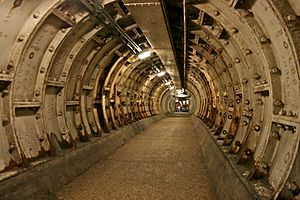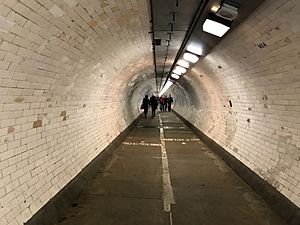Greenwich foot tunnel facts for kids
Quick facts for kids Overview |
|
|---|---|
| Location | Greenwich/Millwall |
| Start | Royal Borough of Greenwich |
| End | London Borough of Tower Hamlets |
| Operation | |
| Traffic | Pedestrian |
| Technical | |
| Design engineer | Sir Alexander Binnie |
| Length | 1,215 feet (370.2 m) |
The Greenwich Foot Tunnel is a cool underground pathway that goes right under the River Thames in East London. It connects Greenwich on the south side of the river with Millwall on the north side.
This tunnel is only for people walking. It's a handy way to cross the river without needing a boat or a long trip on a train.
Contents
Building the Tunnel

A smart engineer named Sir Alexander Binnie designed this tunnel. The building work started in June 1899 and the tunnel opened on 4 August 1902.
Before the tunnel, people had to use a ferry to cross the river. This ferry was often expensive and not always on time. The tunnel made it much easier for workers living south of the Thames to get to their jobs in the docks and shipyards.
A politician named Will Crooks helped make the tunnel happen. He had worked in the docks himself and knew how important it was for people to have an easy way to cross the river.
How the Tunnel Looks Inside
The tunnel has special entrances at both ends with glass domes over them. Inside, there are spiral staircases and lifts to help people get down to the tunnel. The lifts were updated in 1992 and again in 2012.
The tunnel is made of cast-iron rings, covered with concrete and about 200,000 white tiles. It's about 370 meters (1,215 feet) long and about 15 meters (50 feet) deep. The inside is about 2.7 meters (9 feet) wide.
During the Second World War, bombs damaged the northern end of the tunnel. It was repaired with a thick steel and concrete lining, which makes that part a bit narrower. The northern entrance has 87 steps, and the southern entrance has 100 steps.
Where is the Tunnel?
The tunnel connects two important areas:
- Greenwich town centre on the south side of the Thames. The tunnel entrance here is near the famous ship, the Cutty Sark.
- Parts of Docklands, including Canary Wharf, on the north side. The northern entrance is in Island Gardens, a park with great views of the old Greenwich Hospital, the Queen's House, and the Royal Greenwich Observatory.
Because it's deep underground, the tunnel stays cool even on hot days.
Who Uses the Tunnel?
The Greenwich Foot Tunnel is a busy place! About 4,000 people use it every day.
It's part of the UK's National Cycle Route 1, which goes all the way from Inverness to Dover. However, cyclists are usually asked to walk their bikes through the tunnel. The Thames Path, a long walking trail, also uses the tunnel to cross the river.
Tunnel Upgrades
The lifts in the tunnel used to have limited hours and sometimes didn't work. If the lifts weren't working, people who couldn't use the stairs could take the Docklands Light Railway (DLR) between nearby stations. But you can't take non-folding bikes on the DLR during busy times.
Greenwich Council started big upgrade works on the tunnel in 2010. They wanted to fix leaks, improve drainage, and install new lifts, CCTV cameras, and better signs. The work was finished in 2012.
Now, the tunnel has new lifts that people can operate themselves, and signs at the surface show if the lifts are working. There's also better lighting and CCTV.
A group called 'Friends of Greenwich and Woolwich foot tunnels' (FOGWOFT) was started in 2013 to support the tunnels. They helped get a special plaque put up near the Greenwich entrance in 2016, telling the tunnel's story.
In 2016, a special system called Ethos Active Mobility was put in place. It uses cameras to count people and bikes and measure their speed. It shows messages on electronic signs to encourage everyone to be polite and safe. For example, it might say "No cycling allowed" when it's busy or "Please consider pedestrians" when it's quiet. Even with this system, cycling is still not allowed in the tunnel.
Tunnel Entrances
- Greenwich entrance: 51°29′00″N 0°00′37″W / 51.4833°N 0.0102°W
- Tower Hamlets entrance: 51°29′12″N 0°00′33″W / 51.4866°N 0.0093°W
Images for kids






